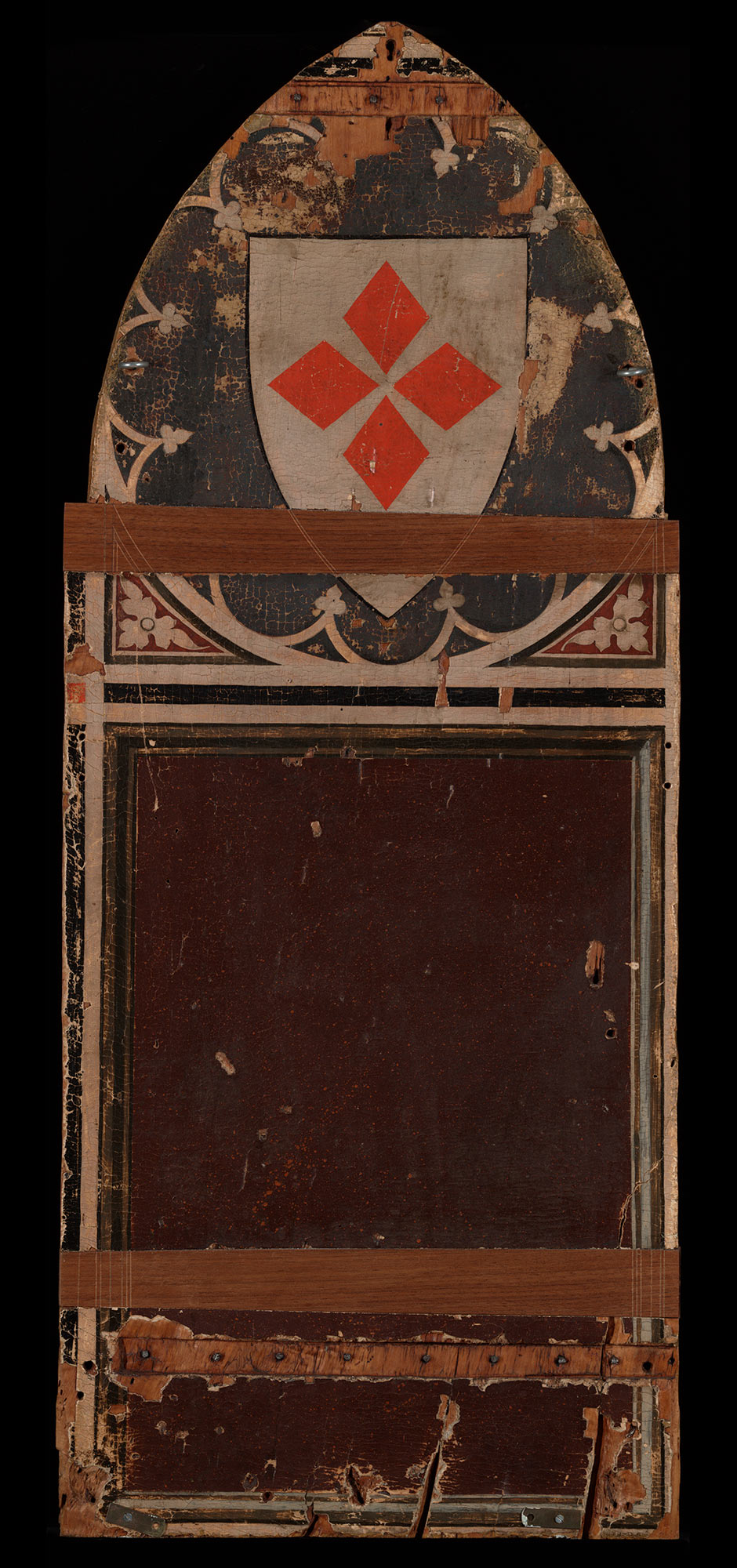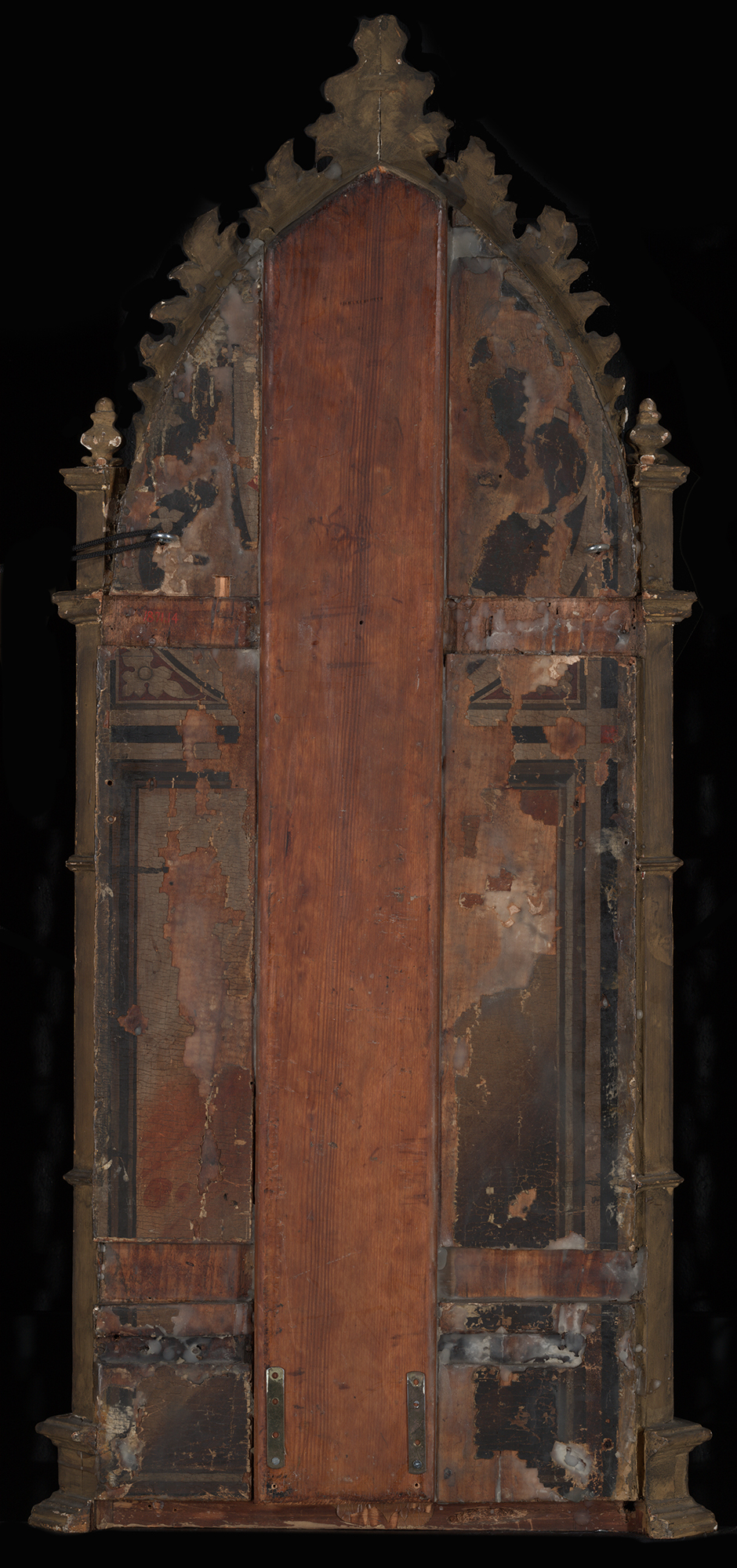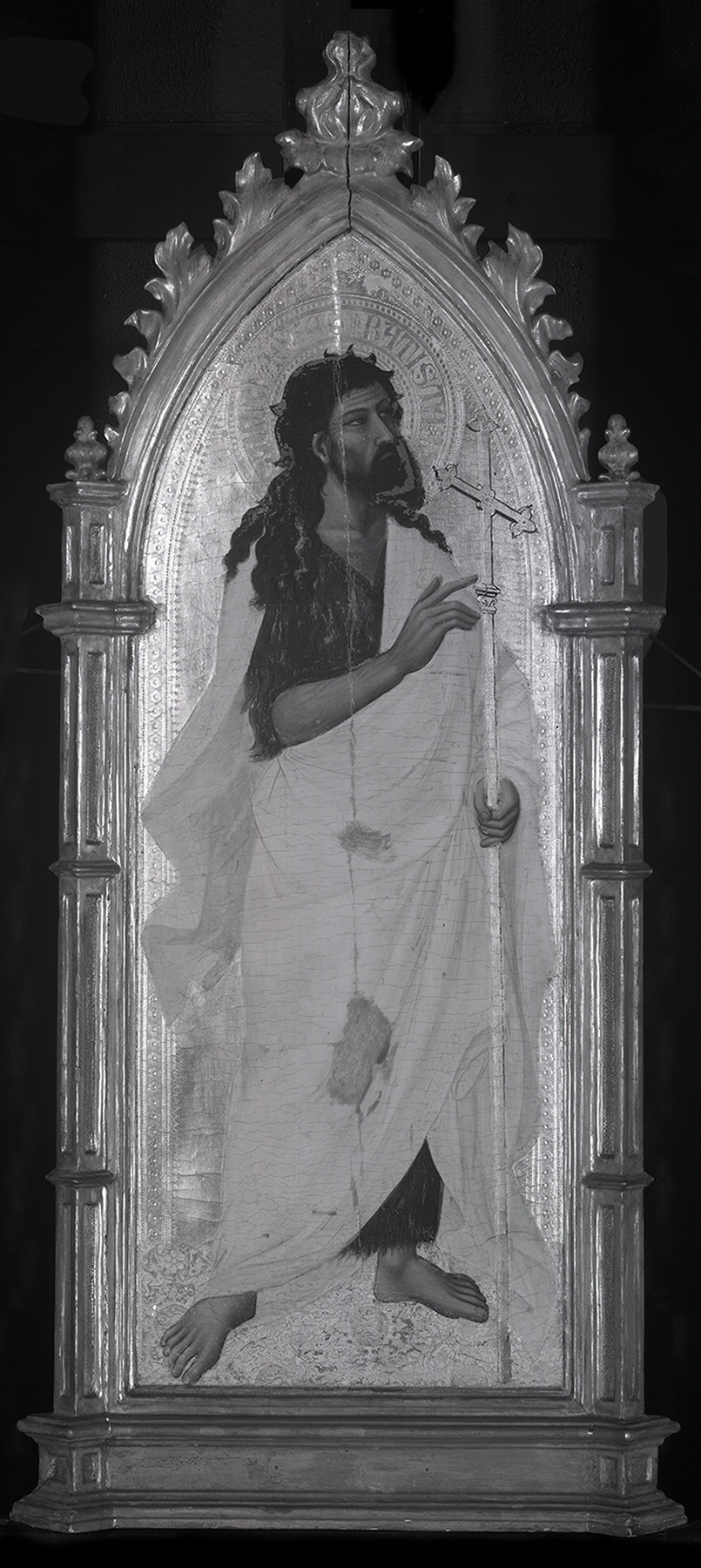James Jackson Jarves (1818–1888), Florence, by 1859
Both panels—the Saint John the Baptist shown here and the Saint Peter catalogued before this entry—are of a vertical grain, are 2 centimeters thick, and have been neither thinned nor cradled, although both were beveled along the front of their lateral edges to accommodate the Gothic Revival frames applied to them in the nineteenth century. The modern frame elements and any original gesso or gilding that might have remained on original moldings were stripped from the Saint Peter panel in a radical cleaning of 1971–72, at which time two battens that had been slotted into its back in the nineteenth century were replaced with new oak battens.1 The nineteenth-century frame was left intact on Saint John the Baptist; the battens on this panel had previously been removed, probably in a cleaning of 1915, when a 13.5-centimeter-wide wooden insert running the full height of the panel was inlaid in its reverse, just left (viewed from the back) of center, to reinforce a split in the support. Both panels have 2.2-centimeter-wide horizontal channels carved in their backs, approximately 12 centimeters and 93 centimeters (on center) from their bottom edges. These were intended to receive iron strap hinges—the nails that affixed them are still preserved in the channels—which would have been recessed just below the painted surface of the reverses and gessoed and painted to continue the decorative patterns that they would otherwise have interrupted. Neither panel has been altered in width or cut at the bottom, but both have been trimmed along the profiles of their ogival arches.
Two large splits rising diagonally from the bottom edge of the Saint Peter have provoked no visible damage to the paint surface of the front and only minor flaking losses on the reverse. The paint surface of the reverse (fig. 1) is exceptionally well preserved, suffering minor flaking only along these splits and at the edges of the hinge channels, and abrasion only along the left (from the back) vertical edge and in the blue (probably smalt) field surrounding the white shield of arms. The paint surface of the front is also well preserved, although it was overcleaned in 1952 and again in 1972. Flaking is apparent only along the left edge of Saint Peter’s yellow cloak and the edge of his blue tunic at the sleeve and shoulder where these painted areas overlap the gold ground. The painted reverse of Saint John the Baptist (fig. 2) has been extensively damaged from flaking losses and from the insertion of the vertical reinforcement, entirely obliterating the white shield of arms in its upper quadrant and leaving only sufficient areas of the lower quadrant to recognize its decoration as fictive marble instead of fictive porphyry, as in the Saint Peter.
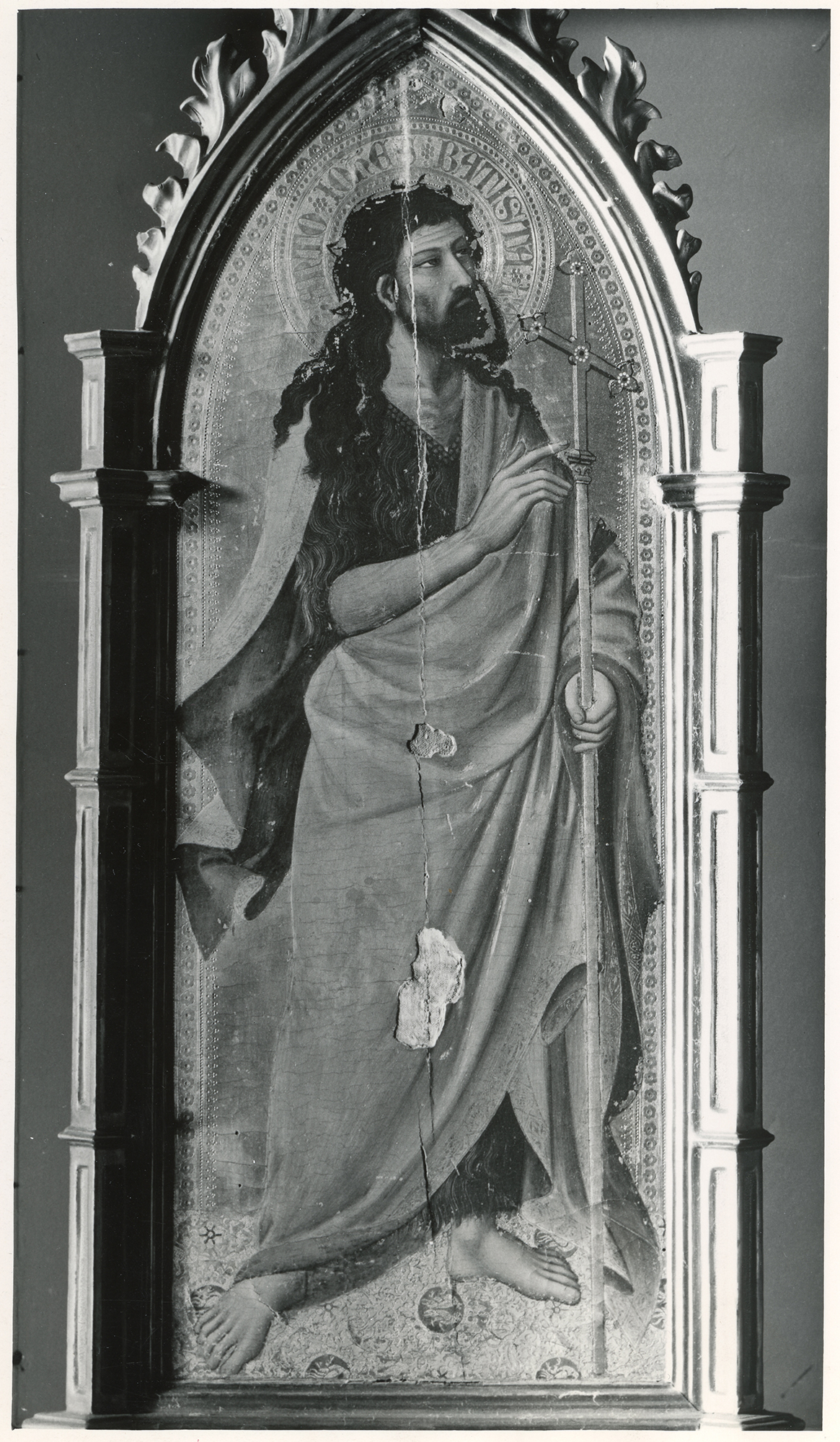
The painted moldings surrounding these decorative fields simulate being lit from the left and above in both panels. The obverse of Saint John the Baptist has been more strongly abraded than Saint Peter and was probably painted more thinly in the first instance. Losses along the vertical center split, including large areas of total loss at the level of the Baptist’s knees and at his waist (fig. 3) have been inpainted, as have scattered flaking losses in his hair and beard. The tips of the toes of the saint’s right foot have been reinforced. The gold grounds of both panels are beautifully preserved.
This panel, showing Saint John the Baptist, and the related Saint Peter, have been the subject of more scholarly agreement than perhaps any other paintings in the Jarves Collection. James Jackson Jarves attributed them to Orcagna at a time when an exaggerated number of mid-trecento panels were labeled with that artist’s name.2 Nevertheless, all publications over the next sixty years accepted the identification without question, until Richard Offner included the panels in his groundbreaking 1924 study of the work of Orcagna’s brother, Nardo di Cione.3 Since then, all references to the Yale panels have considered them canonical works by that artist. So compelling was Offner’s characterization of Nardo’s personality, both in the 1924 article, which focused on the Goldman tabernacle now in the National Gallery of Art, Washington, D.C., and in his later Corpus volume dedicated to the painter’s full career, that no substantive dissension has appeared in subsequent scholarship.4 A small number of newly discovered works have been added to Nardo’s oeuvre but none have been subtracted, while some considerable debate over the chronology of his development has led at best to minor adjustments to the artist’s profile as it was envisioned by Offner. Of the Jarves paintings, Offner stated his belief that they were lateral panels from a disassembled altarpiece probably dating around the time of or shortly following the frescoes in the Strozzi Chapel in Santa Maria Novella, Florence, presumably close to 1357. Hans Gronau assigned them to the decade of the 1360s, at the end of Nardo’s career, as did Angelo Tartuferi.5 Charles Seymour, Jr., concurred with Offner in dating them shortly after the Strozzi Chapel frescoes, in the late 1350s, and refuted a suggestion—the source of which he did not acknowledge—that they may have flanked the Standing Virgin and Child now in the Minneapolis Institute of Art.6 Erling Skaug, who attempted to reconcile the vacillating chronologies of Offner, Gronau, and Miklós Boskovits, was content to leave them in an indeterminate middle period in Nardo’s career, unbracketed by specific dates.7
The single contrary opinion in this long line of agreement appeared in a paper delivered in Milan in 2004 (and published in 2009) by the present author, who noted that while it cannot be doubted that the Jarves Saint Peter and Saint John the Baptist originated from a single complex, they were not designed or painted by the same artist.8 Saint Peter is a massive, frontal figure. His shoulders, hands, and feet are arranged parallel to the picture plane, the tips of the toes aligned as if along a straightedge. The folds of his draperies are shallow, incisive cuts across the picture surface. Saint John the Baptist is long and gaunt and is turned decisively in three-quarter profile. The folds of his pink cape are deep and sculptural, excavating tangible volumes of space around his body. His right hand and both of his feet are not, as in the Saint Peter, geometric abstractions but are carefully articulated, with indications of bone, tendon, and muscle, foreshortened to establish a fully sensible recession into depth. His left hand, even more extremely foreshortened, wraps convincingly around the shaft of the cross he carries—itself set on a spatially recessive diagonal—entirely unlike the symbolic, only vaguely naturalistic grip of Saint Peter upon his keys. Infrared reflectography (figs. 4–5), furthermore, confirms that the underdrawing beneath the figures is by two different draughtsmen. The firm, regular strokes outlining the drapery folds in the Saint Peter, supplemented by light, parallel hatching to indicate shadows, are executed with a quill and are followed closely in the final layers of paint. The drawing beneath the Saint John the Baptist is radically different, comprising a loose, swirling line drawn with a brush, searching out structural forms that are sometimes ignored or corrected in the final paint layers. The more rigid, efficient drawing style of the Saint Peter is identical to that documented beneath Nardo di Cione’s Three Saints altarpiece in the National Gallery, London,9 and Saint Peter’s figure type recurs in Nardo’s Prague altarpiece, in the altarpiece laterals by him in Munich, and in the Goldman tabernacle in Washington.10 Saint John the Baptist, on the other hand, does not correspond in figure type to the same saint in the London or Prague altarpieces—which are both late works—and it must be presumed either not to be by Nardo di Cione or, if by him, to have been conceived at a radically different moment in his career. The panel may instead have been painted by Nardo’s brother Andrea di Cione, known as Orcagna, an argument bolstered by comparison to figures in the Strozzi Chapel altarpiece of 1357 or, ironically, to the kneeling figure of Saint Peter in the Pentecost altarpiece from Santi Apostoli in Florence, both commonly recognized as works by Orcagna.
The problem of collaboration within the joint workshop operated by the Cione brothers has not been adequately addressed in the literature concerning either artist, leading to Skaug’s conclusion that “the widespread idea of a joint workshop between the di Cione brothers seems, on the whole, to crumble up on a closer look at the collected evidence.”11 Clearly, an extended group of other painters was also involved, including Nardo and Andrea’s younger brother, Jacopo di Cione, and as-yet-unnamed artists, such as the Master of the Ashmolean Predella. These artists are assumed to have been working under Andrea’s direction and are frequently credited with having intervened on paintings attributed to him; neither they nor Andrea has been identified as working on paintings attributed to Nardo, whose work is commonly regarded as monolithic in style. Nevertheless, the only parallels for the Jarves Saint John the Baptist—either in figure type or pictorial realization—are to be found entirely among paintings thought to be by Andrea di Cione. Their only echoes within Nardo’s accepted oeuvre occur in the large altarpiece now in the Brooklyn Museum12 and in the frescoes from the Giochi Bastari Chapel in the Badia, Florence. The Brooklyn altarpiece has long been perceived as anomalous among the core group of works thought to be by Nardo. It has been described as his most Orcagnesque painting, a comment perhaps responding to—although not articulating—the perception of a degree of collaboration in its execution. The Giochi Bastari frescoes, equally anomalous among Nardo’s works, have been explained by isolating them as possibly the artist’s earliest efforts. Yet whether they are dated before or after midcentury (no external or circumstantial evidence provides an anchor for dating them to any specific decade), it is essential to recognize that no other painting commonly attributed to Nardo, other than the Jarves Saint John the Baptist, approximates their spatial organization and accomplishment or their uncompromising mastery of sculptural form. The most reasonable explanation for their appearance at any date is the supposition of extensive collaboration within the productive Cione studio.
The 2004 paper in which the Jarves Saint John the Baptist was ascribed to Orcagna’s hand also rectified another misconception about it and the Saint Peter panel: they are not lateral panels from a dispersed altarpiece but shutters to an unusually large tabernacle triptych. The reverse of each panel (see figs. 2–3) retains physical evidence of the iron strap hinges that once affixed them to the central element of the triptych.

Cropping of the painted patterns on the reverses also reveals that the panels were originally much larger and conformed to the standard shape of such shutters: their present ogival arches were filled out by spandrels surmounted by a demilunette at the top. Typically, such lunettes are filled with images of the Annunciatory Angel and the Virgin Annunciate. The latter, originally standing above the Saint Peter, is to be identified with a panel in the T. Robert and Katherine States Burke Collection, in San Francisco (fig. 6). This panel has been cut to a fully arched format but retains a fragmentary band of gilding and punched decoration along its left margin that not only reveals its original demilunette shape but also corresponds to the borders of the Saint Peter and Saint John the Baptist. Identical in thickness to the Jarves panels, the Burke Virgin Annunciate is painted on its reverse with a fictive marble pattern that continues the pattern truncated on the reverse of the Saint Peter. The Burke panel had once been attributed by Millard Meiss to Giovanni del Biondo.13 In refuting that attribution, Offner called attention to “the intensely Nardesque head” of the Virgin, a perceptive comment that can now be amended as an attribution to Nardo himself.14
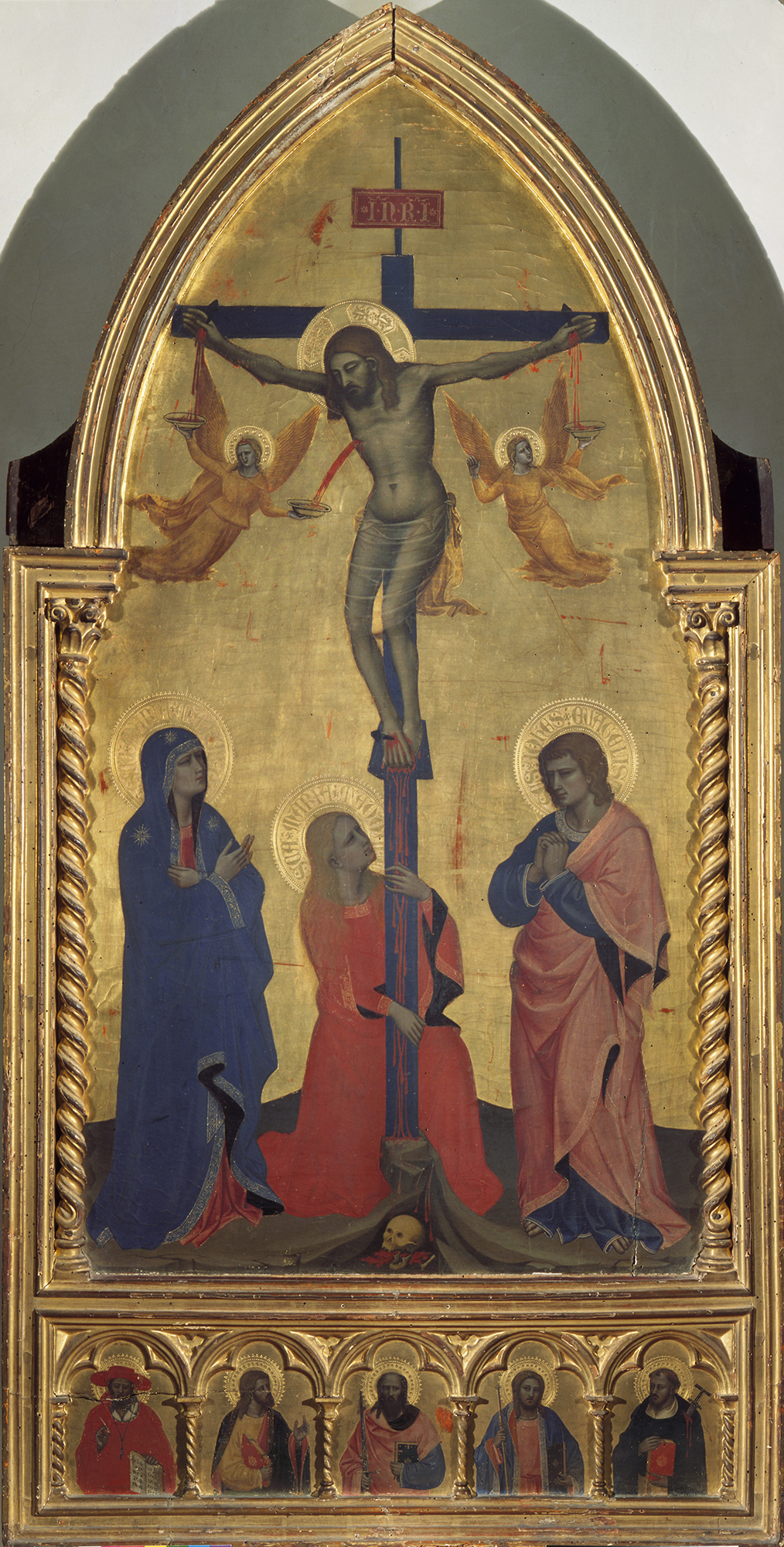
The corresponding lunette of the Annunciatory Angel that once surmounted the Jarves Saint John the Baptist has not yet been recovered, but a proposal to identify the center panel of the tabernacle can now be advanced with some confidence. Of all the surviving works by or close in style to Nardo di Cione, the only one that closely resembles the Jarves Saint Peter in style and in the punched decoration of its gold ground, as well as approximating it in size, is the Crucifixion now in the Gallerie degli Uffizi, Florence (fig. 7). The Uffizi Crucifixion incorporates within its picture field a predella of small, bust-length figures beneath a pastiglia arcade. The five saints portrayed there, significantly, do not include either John the Baptist or Peter, even though their usual companions, John the Evangelist and Paul, are present. Additionally, the upward glance of the Baptist in the left wing of the tabernacle would be logically explained by the elevated position of the crucified Christ in the Uffizi panel, whereas a conventional Virgin and Child Enthroned in the center panel would require the Baptist to be looking to the right at his own level. The engaged moldings surrounding the Uffizi Crucifixion are somewhat unusual for panels of this format. They do not retain evidence of the attachment of hinges, but they may have been intended to elide between the painted surface of the panel and a larger marble tabernacle frame into which it could have been inserted. It would then have been the marble surround to which the hinges on the Jarves panels would have been conjoined, possibly explaining as well the elaborate fictive-marble decoration on the backs of the Jarves panels as hypothetically completing the coloration of the marble tabernacle when the wings were closed.
The Jarves panels incorporate a coat of arms on their reverses (see figs. 1–2)—four red lozenges arranged in a cross on a white ground—that has not been successfully identified but that may relate to a confraternal or civic commission. If, as seems likely, the panels were conceived as pendants to the Uffizi Crucifixion, a clue to that provenance may be supplied by the presence of Saint Peter Martyr among the small-scale figures in the fictive predella in the center panel. Peter Martyr, a Dominican, is credited with founding in 1244 the Societas Sanctissimae Viriginis in Santa Maria Novella, a militant confraternity intended to promote the fight against heresy within the Florentine citizenry. This confraternity gave rise to three others, one of which, the Societas Maior Sanctae Mariae, subsequently known as the Compagnia di Santa Maria del Bigallo, splintered off only one year later. The Bigallo—whose twelve captains, or rectors, were consigned banners of a red cross (signifying the papacy) on a white field—was dedicated to administering hospitals in and around Florence, initially from a seat at San Quirico a Ruballa, near Bagno a Ripoli. The Florentine commune granted them a parcel of land within the city walls, at the corner of the present via Calzolai and Piazza Or San Michele, in 1352. They remained headquartered there until 1425, when Cosimo de’ Medici, then treasurer of the Compagnia del Bigallo, effected their merger with the Compagnia della Misericordia, and they transferred to the present Loggia del Bigallo on Piazza San Giovanni.15
If the Jarves and Uffizi (see fig. 7) panels originally formed a triptych and if that triptych were commissioned by the rectors of the Compagnia del Bigallo, the date 1352—when the Compagnia transferred to Florence and, presumably, began construction of a residence—might be taken as a terminus a quo for its commission. It has already been noted that the two closest stylistic parallels for the Jarves Saint John the Baptist are considered to be relatively early works: the Giochi Bastari frescoes are usually dated before midcentury, and the Brooklyn altarpiece has come to be accepted as probably identical with a painting said to have been signed by Nardo di Cione and dated 1356.16 Skaug’s observation that the punch tools used to decorate the gold grounds in the Jarves Saint Peter and Saint John the Baptist (as well as in the Uffizi Crucifixion) indicate a date for them prior to 1363 is irrefutable, but he could not find any internal evidence within the decorative vocabulary of Nardo’s relatively small oeuvre for finer distinctions of chronology. A date between ca. 1352 and 1356 is plausible, therefore, even if it is not ultimately demonstrable. An alternative proposal by Giovanni Giura, who accepts the reconstruction of the Uffizi/Jarves triptych but believes it can be identified with a tabernacle removed from Santa Maria Novella in 1810, does not contradict this chronology.17 —LK
Published References
Jarves, James Jackson. Descriptive Catalogue of “Old Masters” Collected by James J. Jarves to Illustrate the History of Painting from A.D. 1200 to the Best Periods of Italian Art. Cambridge, Mass.: H. O. Houghton, 1860., 45–46, nos. 34–35; Jarves, James Jackson. Art Studies: The “Old Masters” of Italy; Painting. New York: Derby and Jackson, 1861., no. 13, pl. D; Sturgis, Russell, Jr. Manual of the Jarves Collection of Early Italian Pictures. New Haven: Yale College, 1868., 36–37; W. F. Brown, Boston. Catalogue of the Jarves Collection of Early Italian Pictures. Sale cat. November 9, 1871., 15, nos. 25–26; Rankin, William. “Some Early Italian Pictures in the Jarves Collection of the Yale School of Fine Arts at New Haven.” American Journal of Archaeology 10, no. 2 (April–June 1895): 137–51., 141; Rankin, William. Notes on the Collections of Old Masters at Yale University, the Boston Museum of Fine Arts, the Fogg Museum of Harvard University. Wellesley, Mass.: Department of Art, Wellesley College, 1905., 8, nos. 25–26; Sirén, Osvald. Giottino und seine Stellung in der gleichzeitigen florentinischen Malerei. Kunstwissenschaftliche Studien 1. Leipzig, Germany: Klinkhardt und Biermann, 1908., 70, 89, fig. 30; Sirén, Osvald. “Trecento Pictures in American Collections—II.” Burlington Magazine 14, no. 69 (December 1908): 188, 193–94., 193, pl. 2, no. 1; Berenson, Bernard. The Florentine Painters of the Renaissance with an Index to Their Works. New York: G. P. Putnam’s Sons, 1909., 162; Sirén, Osvald. “Pictures in America by Bernardo Daddi, Taddeo Gaddi, Andrea Orcagna, and His Brothers—I.” Art in America 2, no. 4 (June 1914): 263–75., 270, fig. 3; Sirén, Osvald. A Descriptive Catalogue of the Pictures in the Jarves Collection Belonging to Yale University. New Haven: Yale University Press, 1916., 39–40, no. 13, fig. 13; Sirén, Osvald. Giotto and Some of His Followers. Trans. Frederic Schenck. 2 vols. Cambridge, Mass.: Harvard University Press, 1917., 1:222–24, 275, 2: fig. 190; Offner, Richard. “Italian Pictures at the New York Historical Society and Elsewhere—I.” Art in America 7, no. 4 (June 1919): 148–61., 150–51; van Marle, Raimond. The Development of the Italian Schools of Painting. Vol. 3. The Hague: M. Nijhoff, 1924., 468–69, fig. 264; Offner, Richard. “Nardo di Cione and His Triptych in the Goldman Collection.” Art in America 12, no. 3 (April 1924): 99–112., 101–3, fig. 2; Offner, Richard. Italian Primitives at Yale University: Comments and Revisions. New Haven: Yale University Press, 1927., 97; Offner, Richard. Studies in Florentine Painting: The Fourteenth Century. New York: Sherman, 1927., 97; Salmi, Mario. Review of Italian Primitives at Yale University: Comments and Revisions, by Richard Offner. Rivista d’arte 11 (1929): 267–73., 268; Venturi, Lionello. Pitture italiane in America. 2 vols. Milan: Ulrico Hoepli, 1931., pl. 45; Berenson, Bernard. Italian Pictures of the Renaissance: A List of the Principal Artists and Their Works with an Index of Places. Oxford: Clarendon, 1932., 384; Venturi, Lionello. Italian Paintings in America. Trans. Countess Vanden Heuvel and Charles Marriott. 3 vols. New York: E. Weyhe, 1933., pl. 55; Gronau, Hans D. Andrea Orcagna und Nardo di Cione: Eine stilgeschictliche Untersuchung. Berlin: Deutscher Kunstverlag, 1937., 59, 85n146, fig. 50; Offner, Richard. A Critical and Historical Corpus of Florentine Painting: The Fourteenth Century. Sec. 3, vol. 5, [Master of San Martino alla Palma; Assistant of Daddi; Master of the Fabriano Altarpiece]. New York: Institute of Fine Arts, New York University, 1947., 149, 173; Seymour, Charles, Jr. “The New Conservation Program for Italian Paintings.” Bulletin of the Associates in Fine Arts at Yale University 19, no. 1 (January 1951): unpag., n.p.; Steegmuller, Francis. The Two Lives of James Jackson Jarves. New Haven: Yale University Press, 1951., 296; Toesca, Pietro. Il trecento. Turin: Unione Tipografico Editrice Torinese, 1951., 638, no. 159; Rediscovered Italian Paintings. Exh. cat. New Haven: Yale University Art Gallery, 1952., 16–17; Offner, Richard. A Critical and Historical Corpus of Florentine Painting. Sec. 4, vol. 2, Nardo di Cione. New York: Institute of Fine Arts, New York University, 1960., 61–63; Berenson, Bernard. Italian Pictures of the Renaissance, A List of the Principal Artists and Their Works with an Index of Places: The Florentine School. 2 vols. London: Phaidon, 1963., 1:152; Klesse, Brigitte. Seidenstoffe in der italienischen Malerei des 14. Jahrhunderts. Bern, Switzerland: Stämpfli, 1967., 339, no. 277; Seymour, Charles, Jr. Early Italian Paintings in the Yale University Art Gallery. New Haven: Yale University Art Gallery, 1970., 56–58, nos. 39a–b; Fredericksen, Burton B., and Federico Zeri. Census of Pre-Nineteenth-Century Italian Paintings in North American Public Collections. Cambridge, Mass.: Harvard University Press, 1972., 146, 599; Elsbeth Selver, in Seymour, Charles, Jr., et al. Italian Primitives: The Case History of a Collection and Its Conservation. Exh. cat. New Haven: Yale University Art Gallery, 1972., 14–15, no. 6, figs. 6a–d; Fremantle, Richard. Florentine Gothic Painters from Giotto to Masaccio: A Guide to Painting in and near Florence, 1300 to 1450. London: Secker and Warburg, 1975., fig. 313; Boskovits, Miklós. “Una scheda e qualche suggerimento per un catalogo dei dipinti ai Tatti.” Antichità viva 14, no. 2 (1975): 9–21., 244n211; Skaug, Erling S. Punch Marks from Giotto to Fra Angelico: Attribution, Chronology, and Workshop Relationships in Tuscan Panel Painting, with Particular Consideration to Florence, c. 1330–1430. 2 vols. Oslo: International Institute for Conservation of Historic and Artistic Works—Nordic Group, 1994., 1:176, 2: no. 6.10; Frinta, Mojmír S. Punched Decoration on Late Medieval Panel and Miniature Painting. Vol. 1, Catalogue Raisonné of All Punch Shapes. Prague: Maxdorf, 1998., 227, 512; Tartuferi, Angelo. Dal duecento agli Orcagna: Il restauro della Madonna col Bambino di ignoto fiorentino del duecento e del trittico di Santa Maria degli Angeli di Nardo di Cione. Livorno: Sillabe, 2001., 66, 70, fig. 24; Offner, Richard. A Critical and Historical Corpus of Florentine Painting: The Fourteenth Century. Sec. 3, vol. 5, Bernardo Daddi and His Circle. Ed. Miklós Boskovits. Florence: Giunti, 2001., 383; Kanter, Laurence. “Riconsiderazioni orcagnesche: Due pannelli della collezione Crespi attribuiti al Maestro della Predella dell’Ashmolean Museum.” In I fondi oro della collezione Alberto Crespi al Museo Diocesano di Milano: Questioni iconografiche e attributive; Atti della giornata di studi, 11 ottobre 2004, 48–59. Biblioteca d’arte 18. Milan: Silvana, 2009., 54–59, figs. 10–14
Notes
-
Elsbeth Selver, in Seymour, Charles, Jr., et al. Italian Primitives: The Case History of a Collection and Its Conservation. Exh. cat. New Haven: Yale University Art Gallery, 1972., 14–15, no. 6, figs. 6a–c, illustrates the Saint Peter during the course of the 1971–72 treatment, with the frame elements not yet removed, the lower batten missing, and the upper batten not yet replaced. ↩︎
-
Jarves, James Jackson. Descriptive Catalogue of “Old Masters” Collected by James J. Jarves to Illustrate the History of Painting from A.D. 1200 to the Best Periods of Italian Art. Cambridge, Mass.: H. O. Houghton, 1860., 45–46, no. 26, fig. 26; and Jarves, James Jackson. Art Studies: The “Old Masters” of Italy; Painting. New York: Derby and Jackson, 1861., no. 13, pl. D. ↩︎
-
Offner, Richard. “Nardo di Cione and His Triptych in the Goldman Collection.” Art in America 12, no. 3 (April 1924): 99–112., 101–3, fig. 2. ↩︎
-
Offner, Richard. A Critical and Historical Corpus of Florentine Painting. Sec. 4, vol. 2, Nardo di Cione. New York: Institute of Fine Arts, New York University, 1960., 61–63. For Nardo’s Goldman tabernacle, see National Gallery of Art, Washington, D.C., inv. no. 1939.1.261.a–c, https://www.nga.gov/collection/art-object-page.204932.html. ↩︎
-
Gronau, Hans D. Andrea Orcagna und Nardo di Cione: Eine stilgeschictliche Untersuchung. Berlin: Deutscher Kunstverlag, 1937., 59, 85n146, fig. 50; and Tartuferi, Angelo. Dal duecento agli Orcagna: Il restauro della Madonna col Bambino di ignoto fiorentino del duecento e del trittico di Santa Maria degli Angeli di Nardo di Cione. Livorno: Sillabe, 2001., 66, 70, fig. 24. ↩︎
-
Inv. no. 68.41.7, https://collections.artsmia.org/art/1679/standing-madonna-with-child-nardo-di-cione; Seymour, Charles, Jr. Early Italian Paintings in the Yale University Art Gallery. New Haven: Yale University Art Gallery, 1970., 56–58, nos. 39a–b. ↩︎
-
Boskovits, Miklós. Pittura fiorentina alla vigilia del Rinascimento, 1370–1400. Florence: Edam, 1975., 244n211; and Skaug, Erling S. Punch Marks from Giotto to Fra Angelico: Attribution, Chronology, and Workshop Relationships in Tuscan Panel Painting, with Particular Consideration to Florence, c. 1330–1430. 2 vols. Oslo: International Institute for Conservation of Historic and Artistic Works—Nordic Group, 1994., 1:176, 2: no. 6.10. ↩︎
-
Kanter, Laurence. “Riconsiderazioni orcagnesche: Due pannelli della collezione Crespi attribuiti al Maestro della Predella dell’Ashmolean Museum.” In I fondi oro della collezione Alberto Crespi al Museo Diocesano di Milano: Questioni iconografiche e attributive; Atti della giornata di studi, 11 ottobre 2004, 48–59. Biblioteca d’arte 18. Milan: Silvana, 2009., 48–59. ↩︎
-
Inv. no. NG581, https://www.nationalgallery.org.uk/paintings/nardo-di-cione-three-saints; Bomford, David, Jill Dunkerton, Dillian Gordon, and Ashok Roy, with Jo Kirby. Art in the Making: Italian Painting before 1400. Exh. cat. London: National Gallery, 1989., 126–39, esp. 132–34. ↩︎
-
Narodni Galerie, Prague, inv. no. O.2376-2385; and Alte Pinakothek, Munich, inv. no. W.A.F.1027-1028. For the Goldman tabernacle, see note 4, above. ↩︎
-
Skaug, Erling S. Punch Marks from Giotto to Fra Angelico: Attribution, Chronology, and Workshop Relationships in Tuscan Panel Painting, with Particular Consideration to Florence, c. 1330–1430. 2 vols. Oslo: International Institute for Conservation of Historic and Artistic Works—Nordic Group, 1994., 1:179. Skaug presents an excellent review and analysis of contrasting opinions within the literature on the Cione brothers; see Skaug, Erling S. Punch Marks from Giotto to Fra Angelico: Attribution, Chronology, and Workshop Relationships in Tuscan Panel Painting, with Particular Consideration to Florence, c. 1330–1430. 2 vols. Oslo: International Institute for Conservation of Historic and Artistic Works—Nordic Group, 1994., 1:172–75, 179–80. ↩︎
-
Inv. no. 1995.2, https://www.brooklynmuseum.org/opencollection/objects/4963. ↩︎
-
Meiss, Millard. Painting in Florence and Siena after the Black Death: The Arts, Religion, and Society in the Mid-Fourteenth Century. Princeton, N.J.: Princeton University Press, 1951., 168n4. The Virgin Annunciate was first recorded in the collection of W. B. Chamberlin, Hove, Essex; sale, Christie’s, London, February 25, 1938, lot 21. It reappeared at a sale at the Galerie Charpentier, Paris, June 1, 1951, lot 8, and was subsequently owned by Schaeffer Galleries, New York. It was sold again at Sotheby’s, New York, October 7, 1994, lot 17, and resurfaced on the art market in Florence, where it was purchased by its current owners. The decorative field on its reverse is painted as fictive marble, corresponding to the remains of the field on the reverse of the Jarves Saint John the Baptist. Presumably, the missing Annunciatory Angel had a fictive porphyry reverse corresponding to that on the Jarves Saint Peter. ↩︎
-
Offner, Richard, and Klara Steinweg. A Critical and Historical Corpus of Florentine Painting. Sec. 4, vol. 4, Giovanni del Biondo, pt. 1. New York: Locust Valley, 1967., 91n3; see also Offner, Richard. A Critical and Historical Corpus of Florentine Painting: The Fourteenth Century. Supplement: A Legacy of Attributions. Ed. Hayden B. J. Maginnis. New York: Institute of Fine Arts, New York University, 1981., 36, fig. 65. ↩︎
-
Saalman, Howard. The Bigallo: The Oratory and Residence of the Compagnia del Bigallo e della Misericordia in Florence. New York: New York University Press, 1969.; and Artusi, Luciano, and Antonio Patruno. Deo gratias: Storia, tradizioni, culti e personaggi delle antiche confraternite fiorentine. Rome: Newton Compton, 1994., 237–41. It should be noted that work supposedly undertaken by Nardo di Cione for the Compagnia del Bigallo in October 1363, according to a document published by Offner (“il lavorio che si dee fare del dipignere la volta e le altre cose”), was actually a commission from the captains of the Compagnia della Misericordia, whose accounts were merged with those of the Bigallo in 1425; see Offner, Richard. A Critical and Historical Corpus of Florentine Painting. Sec. 4, vol. 2, Nardo di Cione. New York: Institute of Fine Arts, New York University, 1960., 4. ↩︎
-
This proposal, first advanced by Millard Meiss, was initially accepted by scholars with appropriate hesitation but has come to assume the status of historical fact; see Meiss, Millard. Painting in Florence and Siena after the Black Death: The Arts, Religion, and Society in the Mid-Fourteenth Century. Princeton, N.J.: Princeton University Press, 1951., 15, and, for example, Boskovits, Miklós. Italian Paintings of the Thirteenth and Fourteenth Centuries. Washington, D.C.: National Gallery of Art, 2016. NGA Online Editions, https://purl.org/nga/collection/catalogue/italian-paintings-of-the-thirteenth-and-fourteenth-centuries., 314. It should be noted that the contention is based on iconography and depends upon the attribution. It is a tautology to adduce it as justification for attributions or chronologies. ↩︎
-
Giovanni Giura, email to the author, 2020, in preparation for a forthcoming catalogue of thirteenth- and fourteenth-century paintings at the Gallerie degli Uffizi, Florence. ↩︎
